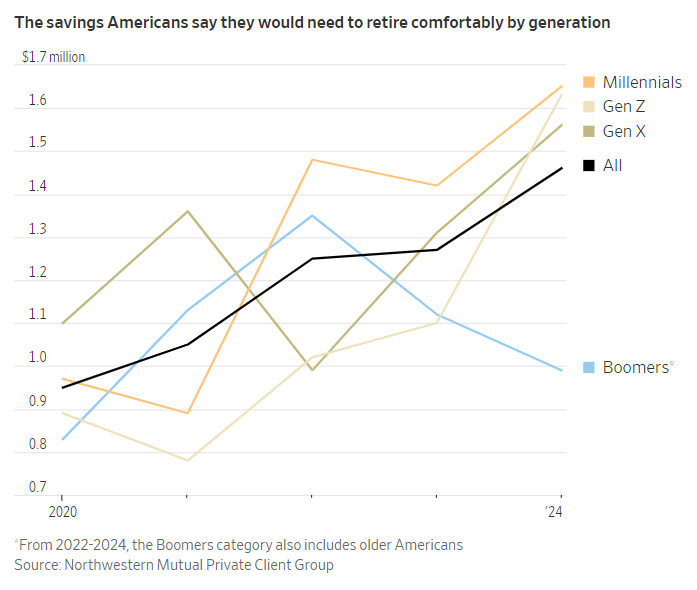
By Anne Tergesen
April 2, 2024
The stock market gave 401(k)s a 19% boost last year. Inflation cooled. Still, lots of people feel no closer to hitting their magic number for retirement.
It would take $1.46 million to retire comfortably, according to a recent survey of 4,588 adults released Tuesday by financial-services company Northwestern Mutual. That is up from $1.27 million a year ago. And over $1 million more than the average survey participant’s nest egg.

Ozzie Hoppe for The Wall Street Journal
The rising magic number reveals more about retirement anxiety than retirement planning, said Teresa Ghilarducci, an economist at the New School for Social Research in New York City.
People don’t really know how much money they will need in retirement, and often overestimate it, Ghilarducci said.
While $1.46 million might make sense as a savings target for some higher-income households, most families with lower incomes likely need far less, she said.
“Anxiety about retirement is sky-high,” she said, noting that concerns about the costs of healthcare and long-term-care add to the worry.
Some of this nest-egg disconnect stems from the shift from pensions to 401(k)-type plans, which require savers to make investment and planning decisions on their own.
Retirees with little financial background have to figure out how to make their nest eggs last for as long as several decades, a task BlackRock Chief Executive Larry Fink called “an impossible math problem” in an annual letter to shareholders last week that raised alarms about a retirement crisis.
It is hard for workers to imagine what their 401(k) balance ultimately buys in retirement. The Wall Street Journal profiled retirees with $1 million, $2 million and $5 million to show the range of lifestyles and challenges people face. About 2% of Fidelity Investment’s 401(k) participants have a balance of $1 million or more.
Understanding how far retirement savings will go is further complicated by the uncertain future of Social Security.
Younger workers, in particular, worry about what looming shortfalls will mean for benefits, said Kurt Rupprecht, partner and private-wealth adviser at K Street Financial, a Northwestern Mutual Private Client Group.
The retirement program is projected to deplete its reserves in a decade, triggering a 23% reduction in benefits unless Congress acts.
Millennials, those born between the early 1980s and late 1990s, sharply raised their estimates compared with before the pandemic. When they retire, millennials now expect to need $1.65 million. That is up from just under $1 million in 2020. Baby boomers, born between 1946 and 1964, said they would need $990,000, up from $830,000 in 2020, according to the poll, the latest installment of which was conducted in January.
People who have at least $1 million to invest think they will need about $4 million to retire comfortably, up from $2.1 million in 2020.
Retirement math
There is no single magic number or formula for knowing when it is financially safe to retire. The actual size of the nest egg you need depends on factors including your income, marital status, expected longevity, where you plan to live in retirement, and whether you want to leave money to heirs, Rupprecht said.
There are rules of thumb to measure your retirement readiness. One shortcut devised by Fidelity Investments, calls for saving 10 times your annual salary by age 67.
Using that guideline, a household with around the median income of $75,000 would need to have $750,000 saved by age 67. A family earning at least $153,001, the threshold for the top 20% of earners, according to the 2022 U.S. Census, should save $1.53 million or more.
To hit those targets, Fidelity recommends saving about 15% a year starting at age 25, including any contribution your employer makes to a 401(k)-type account.

This approach is designed to replace 45% of your income—or $45,000 annually for someone with a $100,000 salary—with Social Security providing the rest.
According to the Federal Reserve, the average American has saved $333,940 in 2022, up from $282,100 in 2016. Households ages 65 to 74 have average retirement savings of about $609,000 in 2022, according to the Fed.
Those polled by Northwestern say they have saved an average of $88,400.
Is it enough?
People often end up retiring earlier than expected, due to job changes or health issues. Others find they already have enough saved.
About 35% of retirees the nonprofit Employee Benefit Research Institute surveyed in 2023 said they retired sooner than planned because they felt they could afford to, down from 41% in 2021.
Younger workers are getting a head start on saving for retirement, compared with older generations. Those in Gen Z, born around 1997 or later, report starting at age 22, compared with 27 for millennials. Baby boomers, who began their careers before employers widely offered automatic enrollment into 401(k) plans, started at an average age of 37, the survey said.
The early start is putting younger workers on track to surpass their elders in retirement savings, according to data from Vanguard Group.
By the time older millennials, around 37 to 41, now earning a median salary reach retirement, Vanguard estimates they will be able to replace almost 60% of their income with Social Security and savings from sources including their 401(k)s and individual retirement accounts.
Gen Xers and the youngest baby boomers with median earnings are, by contrast, likely to replace about half of their paychecks in retirement.
Write to Anne Tergesen at anne.tergesen@wsj.com
Dow Jones & Company, Inc.



